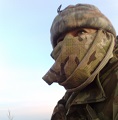Hardening steel targets
49 posts
• Page 1 of 2 • 1, 2
Hardening steel targets
Found a couple of interesting videos today.
He cuts up a CO2 welding bottle, then heat treats three test pieces, and shoots them with .223Rem and 7.62x39mm.
The heat treatment.
https://youtu.be/3XW0Li0UUQw
The testing
https://youtu.be/RMBCDtF-BL0
Do we have any metalurgists in here?
What steel would I want to order to give the best heat treatment for making targets? He says in one of the videos that plain black mild steel won't work.
He cuts up a CO2 welding bottle, then heat treats three test pieces, and shoots them with .223Rem and 7.62x39mm.
The heat treatment.
https://youtu.be/3XW0Li0UUQw
The testing
https://youtu.be/RMBCDtF-BL0
Do we have any metalurgists in here?
What steel would I want to order to give the best heat treatment for making targets? He says in one of the videos that plain black mild steel won't work.
Practice Strict Gun Control - Precision Counts!
-

bladeracer - Field Marshal

- Posts: 13770
- Victoria
Re: Hardening steel targets
I have a good book at home. It’s something to do with some sort of metalwork but I do remember the first chapter dealt with this and metallurgy in a very complex in depth manner .. it was more complicated than I had the patience to pursue. I’ll dig it up and see if it has any appropriate helpful info
- Blr243
- Major General

- Posts: 4779
- Queensland
Re: Hardening steel targets
5150 makes a very tough blade (haha) so it would not hurt giving it a go after one heat cycle and a Quench .
Mild steel will not harden as it does not have enough carbon
Mild steel will not harden as it does not have enough carbon
-

deye243 - Captain

- Posts: 2614
- Victoria
Re: Hardening steel targets
well, you answered your own question...
nothing you can make....in my view.
You need to make an alloy... from scratch ..... think Bisalloy... like carbon / content and the associated alloys....
Don't think there has been a straight steel that has even been bullet proof, no matter what thickness.
nothing you can make....in my view.
You need to make an alloy... from scratch ..... think Bisalloy... like carbon / content and the associated alloys....
Don't think there has been a straight steel that has even been bullet proof, no matter what thickness.
- Apollo
- Warrant Officer C1

- Posts: 1327
- New South Wales
Re: Hardening steel targets
Apollo wrote:well, you answered your own question...
nothing you can make....in my view.
You need to make an alloy... from scratch ..... think Bisalloy... like carbon / content and the associated alloys....
Don't think there has been a straight steel that has even been bullet proof, no matter what thickness.
Did you watch the videos?
Steel cut straight from the CO2 tank stopped .357 Magnum easily, but 7.62x39mm went through like cheese.
Heated until non-magnetic and air-cooled was just barely tougher, indicated by a slightly torn hole.
Heated and water-quenched shattered with the 7.62x39mm.
Heated and oil-quenched stopped 7.62x39mm and .223 easily, so he made body armor out of it and sent it to Matt Carricker to test to destruction.
.375 Cheytac blew it to pieces, but .223rem did nothing to it at all.
So it is certainly possible to harden steel very significantly.
What I've learned thus far though is it needs to be a carbon-steel, with a decent carbon content, I think one-percent or more. So I need to chase up availability of 1510 or something similar.
I have read of covering the surface with hard-weld, but that becomes more expensive than AR500, which is about three-times the price of mild steel. AR500 gongs, 150mm round and 10mm thick are about $50 apiece.
As I have quite a large forge here (Rose's dad enjoying making his own tools), and I'm ordering quite a lot of mild plate, I was hoping I could use the offcuts for some targets. If it turns out that 15-series is not too much more expensive than mild, I could order one sheet of that so I have some offcuts I can harden.
Practice Strict Gun Control - Precision Counts!
-

bladeracer - Field Marshal

- Posts: 13770
- Victoria
Re: Hardening steel targets
Short answer.. I didn't watch the videos... Not interested as I knew the answer. Yes, I studied Metallurgy way back as a kid. Yes I have experimented with calibres of what will dent and/or penetrate steel up to 50mm thick and up to 50cal. Short story really is that small calibre very high velocity is more likely to penetrate armour plate than big heavy calibres...
So. the arguement will continue but I'm not... point made here and waste of time going on with something that has been proven many years ago. Look at ceramic shields.
Cheers.....
So. the arguement will continue but I'm not... point made here and waste of time going on with something that has been proven many years ago. Look at ceramic shields.
Cheers.....
- Apollo
- Warrant Officer C1

- Posts: 1327
- New South Wales
Re: Hardening steel targets
I have some longer range targets 10 mm plate mild steel don't even have a dent in them and that is from 300 WIN MAG 208 grain bullet 7mm Remington Magnum 180g bullets but that's for long-range .
-

deye243 - Captain

- Posts: 2614
- Victoria
Re: Hardening steel targets
Use a 22lr, won't be an issue then. Lol
The greatest invention in the history of man is beer.
https://youtu.be/2v3QrUvYj-Y
SSAA, the powerful gun lobby.

 Now I'm a member.
Now I'm a member. 
Hunt safe. A bit more bang is better.
https://youtu.be/2v3QrUvYj-Y
SSAA, the powerful gun lobby.

Hunt safe. A bit more bang is better.
-

Oldbloke - Field Marshal

- Posts: 13397
- Victoria
Re: Hardening steel targets
deye243 wrote:I have some longer range targets 10 mm plate mild steel don't even have a dent in them and that is from 300 WIN MAG 208 grain bullet 7mm Remington Magnum 180g bullets but that's for long-range .
I have a bunch of AR500 targets for high-velocity and a bunch of mild steel for low-velocity rifles.
I have some more AR500's arriving next week, but I'd love to be able to make them myself.
I don't know what steel is used to make gas bottles, but taking it from high-velocity bullets drilling very neat holes through it, to the same bullets bouncing off without marking the surface, in just fifteen minutes of heating and quenching is pretty impressive.
Practice Strict Gun Control - Precision Counts!
-

bladeracer - Field Marshal

- Posts: 13770
- Victoria
Re: Hardening steel targets
Apollo wrote:Short answer.. I didn't watch the videos... Not interested as I knew the answer. Yes, I studied Metallurgy way back as a kid. Yes I have experimented with calibres of what will dent and/or penetrate steel up to 50mm thick and up to 50cal. Short story really is that small calibre very high velocity is more likely to penetrate armour plate than big heavy calibres...
So. the arguement will continue but I'm not... point made here and waste of time going on with something that has been proven many years ago. Look at ceramic shields.
Cheers.....
Yes, I think most of us understand that velocity beats armour. But that is not pertinant to this thread.
This is about turning non-hardened steel that is very easily penetrated, into hardened steel that laughs at the same bullets. There are at least two ways that I know of, and I haven't looked at metallurgy seriously in nearly thirty years. I thought there might be other ways as well.
If you weren't able or willing to address the question I think you wasted your time posting.
Practice Strict Gun Control - Precision Counts!
-

bladeracer - Field Marshal

- Posts: 13770
- Victoria
Re: Hardening steel targets
bladeracer wrote:deye243 wrote:I have some longer range targets 10 mm plate mild steel don't even have a dent in them and that is from 300 WIN MAG 208 grain bullet 7mm Remington Magnum 180g bullets but that's for long-range .
I have a bunch of AR500 targets for high-velocity and a bunch of mild steel for low-velocity rifles.
I have some more AR500's arriving next week, but I'd love to be able to make them myself.
I don't know what steel is used to make gas bottles, but taking it from high-velocity bullets drilling very neat holes through it, to the same bullets bouncing off without marking the surface, in just fifteen minutes of heating and quenching is pretty impressive.
I have some I made out of ar450 wear plate it's not 500 but is holding up ok so far.
-

deye243 - Captain

- Posts: 2614
- Victoria
Re: Hardening steel targets
As someone else said you can not harden mild steel to any real degree. If you use very high carbon steel and harden it it will most likely shatter. You will need to do a fair bit of research and field testing to find the right beast. Personally I think the AR500 is going to be the easiest if not the cheapest. Perhaps work backwards from steels like AR400 and 500.
- Larry
- Staff Sergeant

- Posts: 965
- -
Re: Hardening steel targets
G'day Bllade, if you talk to the guys at Nordic Edge, they may be able to help. They are suppliers to the knife building fraternity and very knowledgeable about various steels ,their properties and heat treating processes. Otherwise you could try contacting the blacksmithing society in your state. Never tried to make a target, but for knives high carbon steel(1084,1095,5160 etc) need to be tempered after hardening or they can be very brittle.Can break just from being dropped. Also check out Beginner Knifemakers Guild on Facebook. A lot of very smart and skilled guys on there who may be able to help. Good luck. i might ask the question on Knifemakers myself just for interest. Might come in handy.
- Baitlayer
- Private

- Posts: 50
- South Australia
Re: Hardening steel targets
Sorry Blade, Facebook sight is actually Australian Beginner Knife Making Group. Also Gamesan Artisan Suplies worth a chat.
- Baitlayer
- Private

- Posts: 50
- South Australia
Re: Hardening steel targets
Are all pressure vessels made with certain grade of steel? He used CO2, and I'm just thinking that lpg cylinders for cars are dime a dozen, or cheaper. There might be something written about what they need to made from. Could be a cheap source of steel for this if it is high carbon steel.
On a slight digression, I was reading recently in reloading book that above around 4000fps that all projectiles and target materials behave in a liquid fashion. Just wondering how much hardness, maleability etc would affect this, or is that the upper limit? Also makes me think that armor piercing would be better achieved with smaller projectiles at much higher velocity. But I would also think that going by the same logic that this means your barrel would also them be in the same "liquid"state once projectile reaches that velocity, so I imagine a barrel life of a few rounds
On a slight digression, I was reading recently in reloading book that above around 4000fps that all projectiles and target materials behave in a liquid fashion. Just wondering how much hardness, maleability etc would affect this, or is that the upper limit? Also makes me think that armor piercing would be better achieved with smaller projectiles at much higher velocity. But I would also think that going by the same logic that this means your barrel would also them be in the same "liquid"state once projectile reaches that velocity, so I imagine a barrel life of a few rounds
- disco stu
- Sergeant

- Posts: 526
- New South Wales
Re: Hardening steel targets
Try pissing on it to quench. Saw something about Vikings, I think, where they used urine in the quenching process to give superior results to whatever else was being done at the time. Something do do with urea and nitride.  . My memory is vague at best.
. My memory is vague at best.
 . My memory is vague at best.
. My memory is vague at best.-

scoot - Corporal

- Posts: 268
- South Australia
Re: Hardening steel targets
Okay, I finally got around to watching the video's.... what a painful experience. Summary, the guy is a nut case.
The pieces of steel he was playing with certainly are nowhere near the hardness of Bisalloy even 450 yet alone 500 which you can't cut with a hacksaw nor drill with anything.
Now it's been many decades since I played Metallurgy but... I forget, you can get a real rough idea of Mild to Carbon Steel by the colour of sparks that are generated if you can actually make any sort of grinding mark.
Steel tanks etc I wouldn't waste my time playing with.
Been a long time but I don't think my 300mm x 13mm Bisalloy plates cost me anywhere near $50 each including postage costs but that was 10 years ago.. They were about 10kg each posted. Since then I was involved in getting some 500mm x 900mm x 13mm plates for a range. They have been shot with up to anything allowed at the range so no 338L or 50BMG but those plates don't have any dents on them to speak of. My own 500 Bisalloy plates have been shot from 100m to 1,000m and the only damage is the paint coating plus maybe a slight mark on their surface.
Warning.... Don't ever shoot a steel yet alone Bisalloy plate closer than 100m to the firing line or you will wear some fragments that come back at you.
Saying that, a mate shot at a steel 8mm BBQ Plate at 50m with a 30-30 and it put a hole straight through it like it was cut with a drill.
Please think safety....
The pieces of steel he was playing with certainly are nowhere near the hardness of Bisalloy even 450 yet alone 500 which you can't cut with a hacksaw nor drill with anything.
Now it's been many decades since I played Metallurgy but... I forget, you can get a real rough idea of Mild to Carbon Steel by the colour of sparks that are generated if you can actually make any sort of grinding mark.
Steel tanks etc I wouldn't waste my time playing with.
Been a long time but I don't think my 300mm x 13mm Bisalloy plates cost me anywhere near $50 each including postage costs but that was 10 years ago.. They were about 10kg each posted. Since then I was involved in getting some 500mm x 900mm x 13mm plates for a range. They have been shot with up to anything allowed at the range so no 338L or 50BMG but those plates don't have any dents on them to speak of. My own 500 Bisalloy plates have been shot from 100m to 1,000m and the only damage is the paint coating plus maybe a slight mark on their surface.
Warning.... Don't ever shoot a steel yet alone Bisalloy plate closer than 100m to the firing line or you will wear some fragments that come back at you.
Saying that, a mate shot at a steel 8mm BBQ Plate at 50m with a 30-30 and it put a hole straight through it like it was cut with a drill.
Please think safety....
- Apollo
- Warrant Officer C1

- Posts: 1327
- New South Wales
Re: Hardening steel targets
G'day bladeracer, Co2 tanks should be thought of as Pressure Vessels, such as oxy tanks filled to 2500psi, and they are not normal steel but must comply with AS1548-7. You will get poor to no result with higher Manganese steels like 1510 but need to move at least to a fully killed plate like K1045, then harden and temper to your needs. Remember that some Carbon steels to be adequately hardened must be reduced from soak temperature to under 1000F in less than 1 second, so which steel you buy will determine if you have to oil quench or use water/brine. The killed steels will usually oil quench in a home setting very well. As an excercise in "can I do it" you are OK, but as a cost saving plan it will liikely cost you more than just buying abrasion resistant plate hardened to your needs. TIP! Old excavator/bulldozer buckets are often made from AR plate with the leading edge inserts at 450 BHN or higher. Cheers.
- No1Mk3
- Lieutenant

- Posts: 2303
- Victoria
Re: Hardening steel targets
disco stu wrote:Are all pressure vessels made with certain grade of steel? He used CO2, and I'm just thinking that lpg cylinders for cars are dime a dozen, or cheaper. There might be something written about what they need to made from. Could be a cheap source of steel for this if it is high carbon steel.
Most LPG cylinders are galvanized I wouldnt suggest heating these up as the gal will come off which is a toxic gas.
- Larry
- Staff Sergeant

- Posts: 965
- -
Re: Hardening steel targets
Good point on the gal. But the ones I've got are just painted, unless it's gal under the paint. I'm about to turn one into a fire pit so I better check that first. I'm pretty confident just painted though going by the rust they get
- disco stu
- Sergeant

- Posts: 526
- New South Wales
Re: Hardening steel targets
Any steel merchants round your way could ask them if the have any decent off cuts Hi carbon
- pomemax
- Warrant Officer C2

- Posts: 1163
- New South Wales
Re: Hardening steel targets
As others have said. I don't have much to ad specifically. It's like releasing in a way
If you are looking at saving money and only doing a handful of plates tbh get the ar500 targets.
For an experience if what's possible then use the forge. What you are trying to do is case hardening. Making the steel red hot and dunking it in oil is actually trying to put a layer of carbon on the surface. I have also seen blacksmiths pour ash on the red hot tool and then hammer to make it hammer forged.
You could try cromoly steel that's cheap option and hard. Also excavator buckets, esp the blade is a great idea
If you are looking at saving money and only doing a handful of plates tbh get the ar500 targets.
For an experience if what's possible then use the forge. What you are trying to do is case hardening. Making the steel red hot and dunking it in oil is actually trying to put a layer of carbon on the surface. I have also seen blacksmiths pour ash on the red hot tool and then hammer to make it hammer forged.
You could try cromoly steel that's cheap option and hard. Also excavator buckets, esp the blade is a great idea
When good men and women can’t speak the truth, when facts are inconvenient, when integrity and character no longer matter, when ego and self-preservation are more important than national security — then there is nothing left to stop the triumph of evil
-

cz515 - Warrant Officer C2

- Posts: 1032
- Victoria
Re: Hardening steel targets
cz515 wrote:As others have said. I don't have much to ad specifically. It's like releasing in a way
If you are looking at saving money and only doing a handful of plates tbh get the ar500 targets.
For an experience if what's possible then use the forge. What you are trying to do is case hardening. Making the steel red hot and dunking it in oil is actually trying to put a layer of carbon on the surface. I have also seen blacksmiths pour ash on the red hot tool and then hammer to make it hammer forged.
You could try cromoly steel that's cheap option and hard. Also excavator buckets, esp the blade is a great idea
G'day cz515,
This is not actually what happens, heat treatable steel undergoes complete chemical and structural changes during treatment, mild(low carbon) steel cannot be hardened in such a way so surface treatmenta are applied such as case hardening which chemically alters the surface to a small degree, essentially making a hard/tough skin by chemical alteration and commonly done with cyanide salts, another method is pack carburation and your mentioned method of surface carburation which is old and highly variuable in results. AR plates are in fact made, by heat treating either high carbon, or more often alloy steel plates to the desired harness. This is what bladeracer needs to do, take a good heat treatable steel and apply his own hardening and tempering to achieve a usable plate, but he must start with an appropriate steel, I mentioned killed plate in my post as it will be the easiest to find and cheapest to buy. Alas the range of steels we used to get in this country has been drastically reduced with the loss of our own steel industry and the advent of imported steels, Cheers.
- No1Mk3
- Lieutenant

- Posts: 2303
- Victoria
Re: Hardening steel targets
Larry wrote:As someone else said you can not harden mild steel to any real degree. If you use very high carbon steel and harden it it will most likely shatter. You will need to do a fair bit of research and field testing to find the right beast. Personally I think the AR500 is going to be the easiest if not the cheapest. Perhaps work backwards from steels like AR400 and 500.
This stuff was fine against the .223 and 7.62x39mm, but the .375 Cheytac blew it to pieces. But I haven't seen what such a cartridge does to AR500 plate at close range either, I thought it just drills through it?
I'm leaning toward that myself. I can only cut it with gas or angle grinder though, which I figure weakens it?
For the effort, it is certainly easier, and probably cheaper to just buy targets, although that restricts me to whatever shape the maker decides is good.
As I said, I'm ordering several sheets of steel to build a new safe so I'll have off-cuts anyway, would have been nice to be able to use them for targets.
Practice Strict Gun Control - Precision Counts!
-

bladeracer - Field Marshal

- Posts: 13770
- Victoria
Re: Hardening steel targets
disco stu wrote:Are all pressure vessels made with certain grade of steel? He used CO2, and I'm just thinking that lpg cylinders for cars are dime a dozen, or cheaper. There might be something written about what they need to made from. Could be a cheap source of steel for this if it is high carbon steel.
On a slight digression, I was reading recently in reloading book that above around 4000fps that all projectiles and target materials behave in a liquid fashion. Just wondering how much hardness, maleability etc would affect this, or is that the upper limit? Also makes me think that armor piercing would be better achieved with smaller projectiles at much higher velocity. But I would also think that going by the same logic that this means your barrel would also them be in the same "liquid"state once projectile reaches that velocity, so I imagine a barrel life of a few rounds
No, LPG bottles are not classed as pressure vessels as far as I'm aware.
The .204 Ruger shoots at 4400fps, as do several other cartridges, without melting the barrels
The 24gn bullet goes through 8mm structural steel at 50m.
So does 180gn cast lead 8x57mm at 2550fps.
Practice Strict Gun Control - Precision Counts!
-

bladeracer - Field Marshal

- Posts: 13770
- Victoria
Re: Hardening steel targets
scoot wrote:Try pissing on it to quench. Saw something about Vikings, I think, where they used urine in the quenching process to give superior results to whatever else was being done at the time. Something do do with urea and nitride.. My memory is vague at best.
Yes, there a few different "brine" quenches as well.
Practice Strict Gun Control - Precision Counts!
-

bladeracer - Field Marshal

- Posts: 13770
- Victoria
Re: Hardening steel targets
I have no doubt he's a nutter, the best people are 
The steel was not hardened initially, it was just a CO2 tank, it stopped .357 Magnum with a decent dent, but rifle bullets went through very cleanly, no dent.
He then treated three sample pieces as I listed earlier. The oil-quenched sample stopped the rifle bullets very easily, with no damage to the steel. He then built the body armour out of that and sent it to Demolition Ranch for testing. It had no difficulty stopping multiple AR and AK hits.
A 300x12mm AR500 target nowadays is around $80.
But I'm more interested in Metallic Silhouettes than circles.
Yes, I have a bunch of AR500 targets already, and nothing marks them.
The steel was not hardened initially, it was just a CO2 tank, it stopped .357 Magnum with a decent dent, but rifle bullets went through very cleanly, no dent.
He then treated three sample pieces as I listed earlier. The oil-quenched sample stopped the rifle bullets very easily, with no damage to the steel. He then built the body armour out of that and sent it to Demolition Ranch for testing. It had no difficulty stopping multiple AR and AK hits.
A 300x12mm AR500 target nowadays is around $80.
But I'm more interested in Metallic Silhouettes than circles.
Yes, I have a bunch of AR500 targets already, and nothing marks them.
Apollo wrote:Okay, I finally got around to watching the video's.... what a painful experience. Summary, the guy is a nut case.
The pieces of steel he was playing with certainly are nowhere near the hardness of Bisalloy even 450 yet alone 500 which you can't cut with a hacksaw nor drill with anything.
Now it's been many decades since I played Metallurgy but... I forget, you can get a real rough idea of Mild to Carbon Steel by the colour of sparks that are generated if you can actually make any sort of grinding mark.
Steel tanks etc I wouldn't waste my time playing with.
Been a long time but I don't think my 300mm x 13mm Bisalloy plates cost me anywhere near $50 each including postage costs but that was 10 years ago.. They were about 10kg each posted. Since then I was involved in getting some 500mm x 900mm x 13mm plates for a range. They have been shot with up to anything allowed at the range so no 338L or 50BMG but those plates don't have any dents on them to speak of. My own 500 Bisalloy plates have been shot from 100m to 1,000m and the only damage is the paint coating plus maybe a slight mark on their surface.
Warning.... Don't ever shoot a steel yet alone Bisalloy plate closer than 100m to the firing line or you will wear some fragments that come back at you.
Saying that, a mate shot at a steel 8mm BBQ Plate at 50m with a 30-30 and it put a hole straight through it like it was cut with a drill.
Please think safety....
Practice Strict Gun Control - Precision Counts!
-

bladeracer - Field Marshal

- Posts: 13770
- Victoria
Re: Hardening steel targets
No1Mk3 wrote:G'day bladeracer, Co2 tanks should be thought of as Pressure Vessels, such as oxy tanks filled to 2500psi, and they are not normal steel but must comply with AS1548-7. You will get poor to no result with higher Manganese steels like 1510 but need to move at least to a fully killed plate like K1045, then harden and temper to your needs. Remember that some Carbon steels to be adequately hardened must be reduced from soak temperature to under 1000F in less than 1 second, so which steel you buy will determine if you have to oil quench or use water/brine. The killed steels will usually oil quench in a home setting very well. As an excercise in "can I do it" you are OK, but as a cost saving plan it will liikely cost you more than just buying abrasion resistant plate hardened to your needs. TIP! Old excavator/bulldozer buckets are often made from AR plate with the leading edge inserts at 450 BHN or higher. Cheers.
I'm leaning toward it not being cost-effective now
The problem with buying pre-hardened plate is I'm not equipped to cut it to shape without getting it fairly hot with a grinder, or very hot with gas.
I know about bucket inserts, but I don't have a handy source for such things. I'll have to wander down to the quarry and ask if they get rid of such things for scrap.
Practice Strict Gun Control - Precision Counts!
-

bladeracer - Field Marshal

- Posts: 13770
- Victoria
Re: Hardening steel targets
pomemax wrote:Any steel merchants round your way could ask them if the have any decent off cuts Hi carbon
There is quite a lot of steel fabrication around here so I really should have an ask around.
Practice Strict Gun Control - Precision Counts!
-

bladeracer - Field Marshal

- Posts: 13770
- Victoria
49 posts
• Page 1 of 2 • 1, 2

